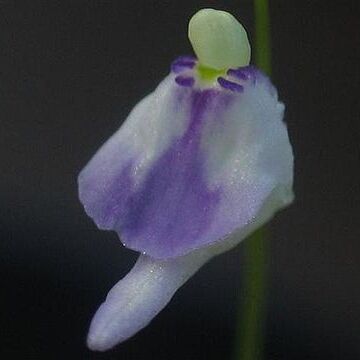Terrestrial herb.. Rhizoids and stolons capillary, numerous from the base of the scape.. Leaves usually numerous at anthesis, scattered on the stolons, linear-oblanceolate to obovate-spathulate, 2–15 mm. long, 0.3–2 mm. wide, 1-nerved.. Traps numerous, ovoid, stalked, 0.6–1.0 mm. long; mouth terminal; upper lip projecting ± twice as much as the lower, both provided with radiating rows of glandular hairs.. Inflorescence erect, 2–16 cm. high; flowers 1–5(–8), distant; scape filiform, smooth above, usually papillose at the base; scales few, similar to the bracts; bracts basifixed, ovate-lanceolate, acute, ± 1 mm. long; bracteoles similar but narrower; pedicels 0.5–1 mm. long.. Calyx-lobes subequal, the upper slightly larger, broadly ovate, acute, lower ovate-oblong, rounded or truncate.. Corolla white or lilac with a yellow spot on the palate, 3–7 mm. long; upper lip narrowly oblong, ±1.5 times as long as the upper calyx-lobe, apex rounded, truncate or emarginate; lower lip orbicular; palate raised, double-crested, the crests smooth or transversely tuberculate; spur conical-subulate, ± twice as long as the lower lip.. Filaments filiform; anther-thecae subdistinct.. Ovary ovoid; style very short; stigma lower lip semi-orbicular, upper much smaller, deltoid.. Capsule globose, 1.5–2.5 mm. in diameter, dehiscing by longitudinal ab-and adaxial slits with thickened margins.. Seeds numerous, ± 0.2 mm. long, truncate-conical, angular; testa smooth, cells indistinct, oblong.
Terrestrial herb. Leaves with blade linear, narrowly obovate to spathulate, 2-15 mm long, 1-veined. Flowers: bracteoles present, bracts not > twice as wide as bracteoles and similar in shape; base of peduncle usually papillose; corolla with spur ± twice as long as lower petal lip, 3-9 mm long, white or lilac with a yellow spot on palate; Jan.-May. Traps ovoid, 0.6-1.0 mm long.
Corolla white or lilac with a yellow spot on the palate, 3–7 mm. long; superior lip narrowly oblong, more or less 1.5 times as long as the upper calyx lobe, with apex rounded, truncate or emarginate; inferior lip circular; palate raised, double-crested, the crest smooth or transversely tuberculate; spur conical-subulate, more or less twice as long as the inferior lip.
Inflorescence erect, 2–16 cm. high; flowers 1–5(8), distant; scape filiform, smooth above, usually papillose at the base; scales few, similar to the bracts; bracts basifixed, ovate-lanceolate, acute, more or less 1 mm. long; bracteoles similar but narrower; pedicels 0.5–1 mm. long.
Leaves usually numerous at anthesis, scattered on the stolons, linear-oblanceolate to obovate-spathulate, 2–15 mm. long, 0.3–2 mm. wide, 1-nerved.
Traps numerous, ovoid, stalked, 0.6–1.0 mm. long; mouth terminal provided with dorsal and ventral radiating rows of glandular hairs.
Capsule globose, 1.5–2.5 mm. in diam., dehisceing by longitidinal dorsal and ventral slits with thickened margins.
Calyx lobes subequal, the upper slightly larger, broadly ovate, acute, lower ovate-oblong, rounded or truncate.
Seeds numerous, more or less 0.2 mm. long, truncate-conical, angular; testa smooth, cells indistinct, oblong.
Ovary ovoid; style very short; inferior lip of stigma semi-circular, the superior deltoid, much smaller.
Rhizoids and stolons capillary, numerous from the base of the peduncle.
Filaments filiform; anther-thecae subdistinct.
Erect, delicate herb 2-6 ins. tall
Bearing 2-4 white or mauve flowers
Leaves oblanceolate-spathulate.
Terrestrial herb.

